On July 21st the last batch of 8,000 juvenile smallmouth bass were stocked in the upper Potomac River at the Williamsport boat ramp. Due to high temperatures, only one location was stocked to reduce handling stress on the fish. A total of 38,000 juvenile smallmouth bass were successfully stocked into the river in 2022.
Smallmouth bass spawning was successful at the DNR Cedarville Hatchery. After the fry emerged from their nests they were transferred to several grow-out ponds and held until they reached 2-3 inches in size. On June 14th a total of 15,000 smallmouth bass fingerlings were stocked in the upper Potomac River at Taylors Landing, Snyders Landing, Shepherdstown, and Dargan Bend boat ramps. On June 29th an additional 15,000 smallmouth bass fingerlings were stocked at Brunswick, Point of Rocks, Nolands Ferry, Whites Ferry, and Edwards Ferry boat ramps.

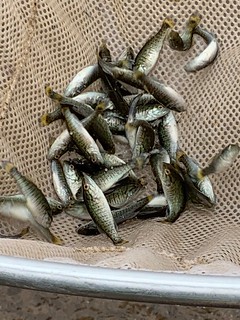




April 2022
August 2021
Annual smallmouth bass juvenile seine surveys were conducted in July and August on the upper Potomac River, Monocacy River, and Conococheague Creek to monitor spawning success and young-of-year numbers. On the upper Potomac River, stations were sampled from Seneca upstream to Oldtown. Overall seine index score was 0.98 fish/seine which is just at the long-term median score of 1 fish/seine. Spawning was successful on the river, but scores were lower than expected given the moderate river flow levels during the spawning period. Seining scores for both the Monocacy and Conococheague were slightly below their long-term median values.
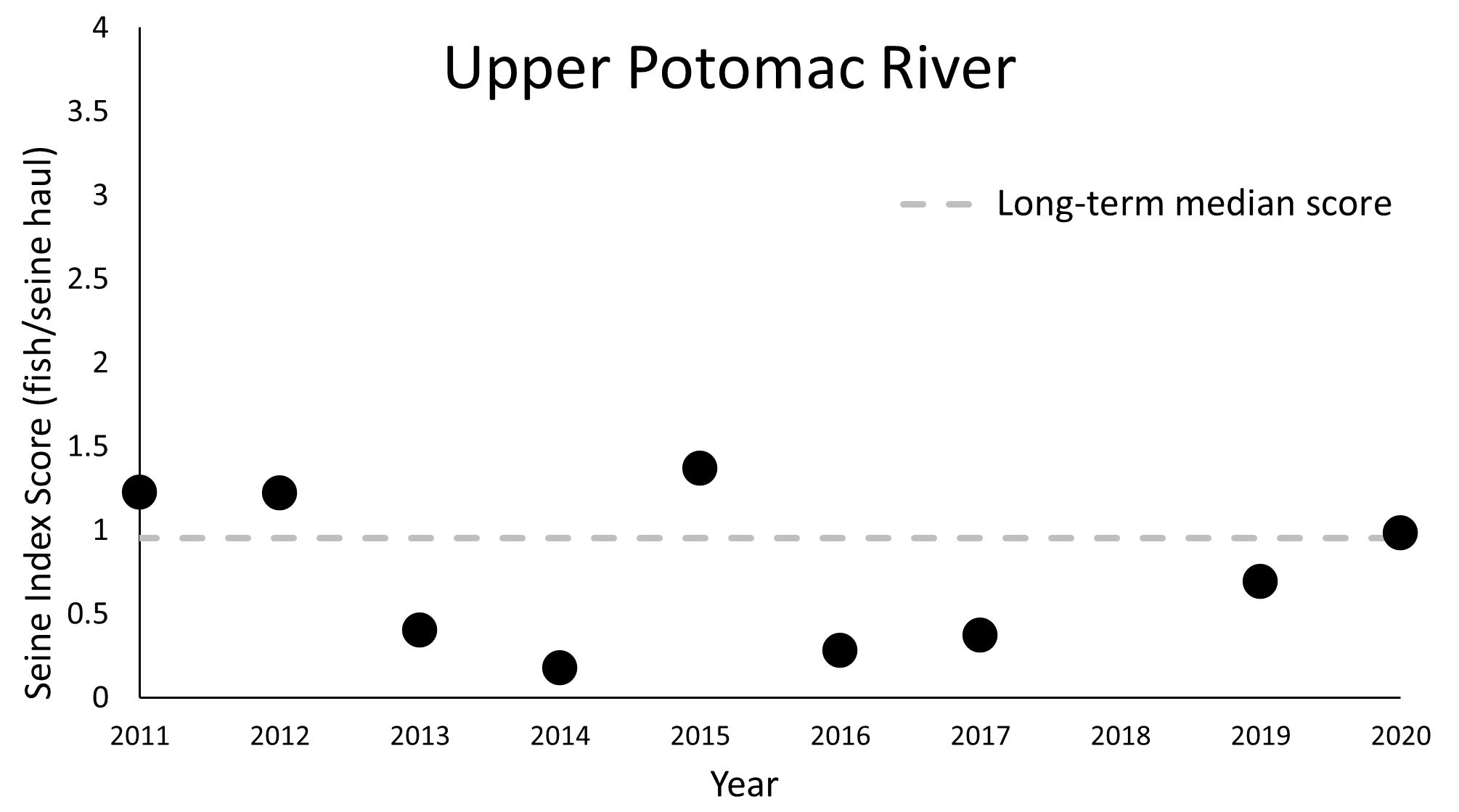 ---------------------------------------------------------------------------------------------------------------------------------------
---------------------------------------------------------------------------------------------------------------------------------------

---------------------------------------------------------------------------------------------------------------------------------------
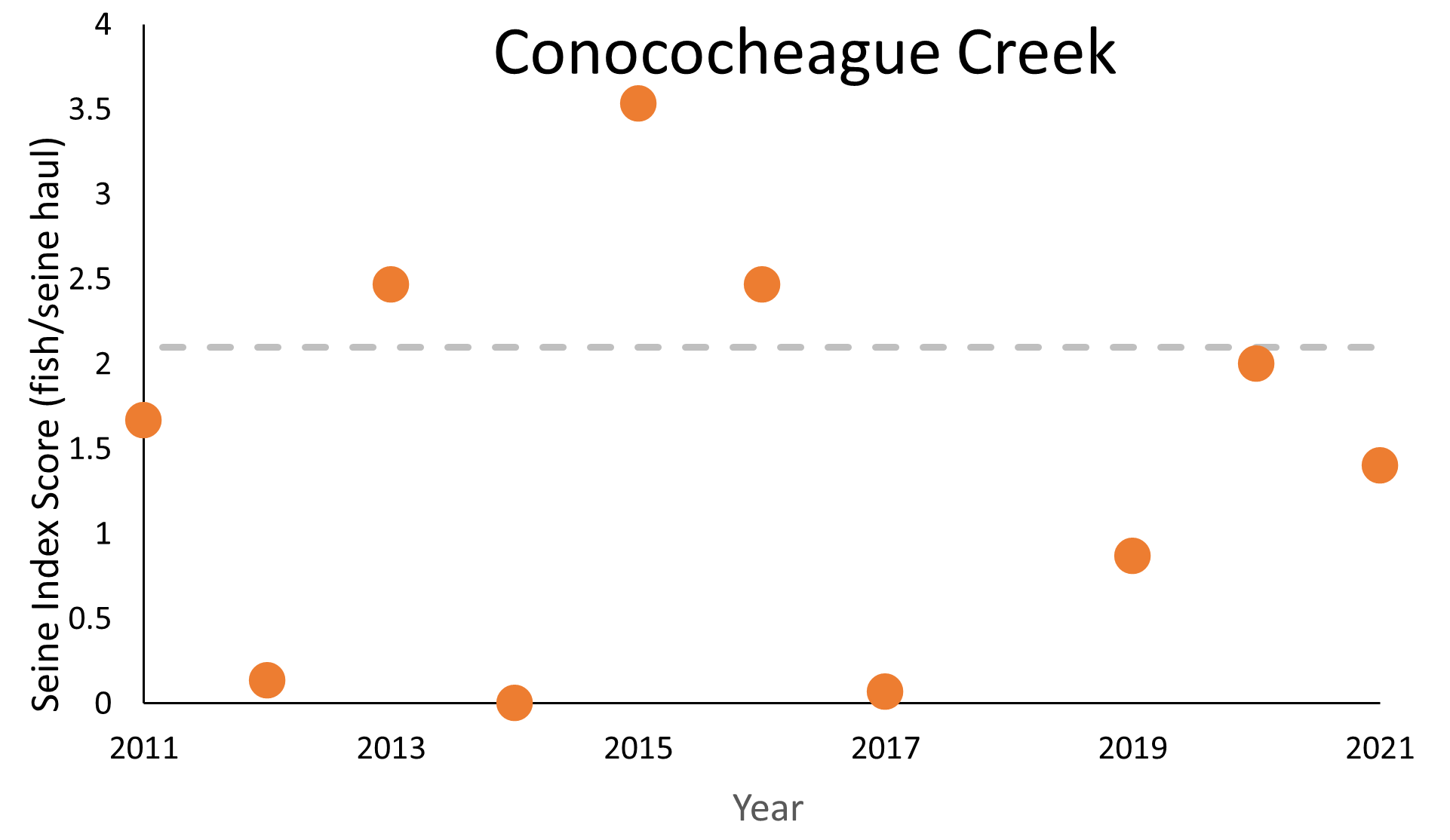
Unfortunately, multiple smallmouth bass young-of-year were observed with skin lesions on the upper Potomac River . Roughly 30% of the juvenile smallmouth bass collected in some areas had external lesions present. Fish with lesions were observed to be less responsive and to have difficulty swimming effectively when compared to healthy juveniles. These fish were retained and sent to researchers at the USGS Leetown Science Center for additional fish health testing.
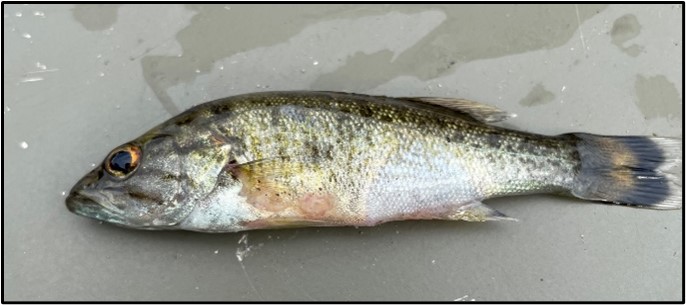

July 2021
Efforts to produce hatchery smallmouth bass juveniles were again started in spring 2021. Adult smallmouth bass brood stock from the upper Potomac River were collected through a combination of boat electrofishing and three volunteer angler tournaments. All adult fish were transported to the Maryland DNR warmwater hatchery and placed in three ponds prepared with gravel spawning boxes. Spawning was successful in late April and fry were observed by mid-May. The adult brood fish were removed from the ponds and safely returned to the upper Potomac River. The smallmouth bass juveniles were left in the ponds until June at which time they had consumed all of the available zooplankton. Unfortunately, in the process of transferring the smallmouth bass juveniles from the outdoor pond into indoor tanks, there was a mechanical issue with an aerator causing a drop in dissolved oxygen levels. Almost all of the juveniles were lost during this incident. Roughly 1000 juvenile smallmouth bass did survive and were placed into an indoor circular tank. These fish were allowed to grow to 2 inches in size before being stocked in the Seneca section of the upper Potomac River in early July.
August 5, 2020
Juvenile smallmouth bass seining surveys have been completed on the upper Potomac, Monocacy, and Conococheague river systems. Monitoring surveys are conducted every summer to check for natural reproduction and judge the relative strength of each years’ juvenile numbers. A 30ft shoreline seine is used for sampling at fixed stations along the length of these rivers. For the upper Potomac River juvenile numbers looked good with an average seine index score of 1.1 fish/seine haul. This is slightly higher than the long-term median score of 1.0 fish/seine haul. Juvenile recruitment also looked good for the Monocacy River with a seine index score of 1.6 fish/seine haul compared to the long-term median of 1.5 fish/seine haul. Conococheague Creek had a juvenile seine index score of 2.0 fish/seine haul, slightly below the long-term median of 2.2 fish/seine haul. This year’s successful spawning combined with the supplemental stocking of hatchery raised smallmouth bass in mainstem sections of the upper Potomac River should help raise adult numbers over the next few years.

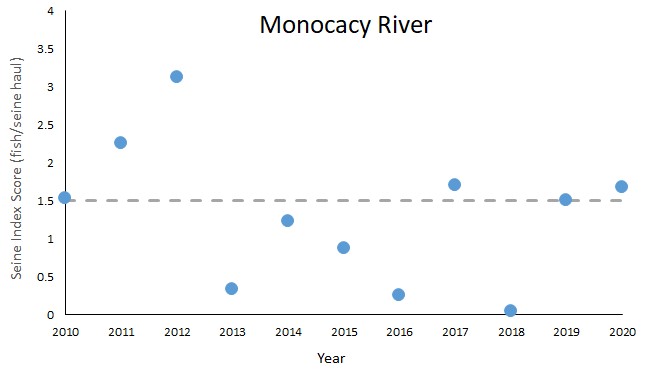
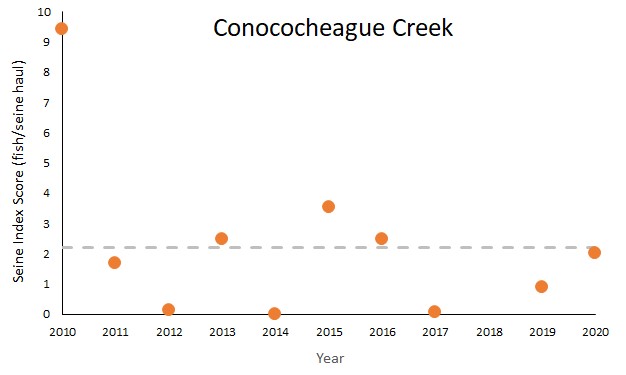
July 14 - 15, 2020
Fishing and Boating Services Hatcheries Division and Freshwater Fisheries Program stocked 30,000 fingerling smallmouth bass in the Potomac River from Taylors Landing downstream to Edwards Ferry. Freshwater staff collected adult smallmouth bass from the Potomac in April to serve as hatchery brood. Over the last four months, staff at the
Joseph Manning Hatchery spawned the bass in ponds with artificial nesting structures and reared the fry in fertilized ponds. Once growth had been maximized in the ponds, the bass were transferred to indoor circular tanks where they were trained to feed on an artificial diet to accelerate growth to a stockable size of 2 - 3 inches. The final step was transporting these fish to the Potomac River.
An additional 5,000 fingerling smallmouth were generously provided by the West Virginia Division of Natural Resources, Warmwater Hatchery Program for the Potomac, which forms Maryland's southern border and is popular with anglers from both states. Several consecutive years of high river flows during the spring have reduced spawning success causing lower catch rates for anglers. The hatchery fish will supplement natural reproduction, accelerating the recovery of the fishery and improving fishing.






Click on the images to view larger size.
July 2, 2020
To aid in efforts to increase adult bass numbers in the upper Potomac River, the Big Slackwater section was recently stocked with 4000 hatchery raised juvenile largemouth bass. The fish measuring rough 1 inch in size were produced at the DNR Manning Hatchery. The juvenile largemouth bass should do well in this impounded section of the river and reach a catchable size in the next 2-3 years.
June 11, 2020
Hatchery managers at the Joseph Manning Hatchery brought approximately 22,000 smallmouth bass fingerlings from the outdoor rearing pond to indoor circular tanks. This lot of fingerlings will be trained on an artificial diet. Once they reach a suitable size (2 - 3 inches), they will be tagged with a coded wire tag and released into the Potomac River. The tags will enable biologists to identify the hatchery fish during future electrofishing surveys and determine their contribution to the fishery (photos provided by Manning Hatchery).
May 20, 2020
After successfully spawning on prepared nesting boxes at the Manning Warmwater Hatchery, the brood smallmouth were returned to the Potomac River. Hatchery staff did a great job caring for these fish during the entire transport and spawning process. The healthy bass were released where they were collected by Freshwater Fisheries biologists earlier this spring.
With the planned spring bass tournament canceled due to Covid-19, in late April Freshwater Fisheries staff were able to collect 40 adult fish by boat electrofishing from the upper Potomac River for use as broodfish in the state’s warmwater hatchery. Staff wore the recommended PPE and practiced social-distancing guidelines throughout the collection. Fish ranged in size from 14-19 inches, with several weighing more than 4 pounds. Smallmouth bass were transported to the hatchery and stocked into two ponds prepared with gravel spawning boxes. As pond temperatures increased, spawning activity was observed on the gravel beds in both ponds. Recently, smallmouth bass fry have been seen swimming by several of the boxes. The fry will be kept in these ponds for several more weeks before they are drained to get a better estimate of their numbers. The fish will then be transferred to grow-out ponds where they will be held through the summer. The plan is to try and grow the smallmouth bass to advanced fingerling size (3-5 inches) before stocking them back into the upper Potomac River later this fall.
April 2, 2020With the state operating under a stay-at-home order, the spring smallmouth bass tournament scheduled to help collect adult broodfish for the hatchery has been canceled.
Tournament angler and department staff health and safety are our top priority during this public health emergency. The focus will shift to the 15 adult smallmouth bass collected earlier this year and currently being held at a hatchery pond at the USGS Leetown Science Center. Spawning boxes have been constructed and installed in the pond. As water temperatures start to increase, spawning activity should hopefully start in the next few weeks.
January 13, 2020
In early January 2020, a group of dedicated anglers volunteered their time and skills to collect adult smallmouth bass from the upper Potomac River in support of supplemental stocking efforts. A total of 15 smallmouth bass, with an average length of 15”, were transported to a 0.5-acre pond at the United States Geologic Survey (USGS) Leetown Science Center. The Maryland Department of Natural Resources Freshwater Fisheries Program has partnered with USGS in a collaborative effort to try and produce smallmouth bass to enhance the current natural population. The fish were collected in January to allow them sufficient time to acclimate to pond conditions prior to spring spawning. The hope is that this will increase the likelihood of successful reproduction. Additional updates will be provided in the coming months.
January 8, 2020
Freshwater Fisheries conducted its annual fall electrofishing survey to assess adult smallmouth bass numbers in the upper Potomac River. For 2019, eleven stations were sampled from Edwards Ferry upstream to Paw Paw, WV. Unfortunately, as expected, electrofishing catch rates for quality size smallmouth bass (>11 inches in length) were below average (Figure 1). The 2019 average catch rate for the entire river was 20 fish/hr. This is lower than the long-term median catch rate of 23 fish/hr. The poor smallmouth bass year-classes that the upper Potomac River has been experiencing due to high spring flow levels over the past several years are the primary factor behind this trend. With fewer new fish entering the population, there are few adult fish over time.
Figure 1. Mean annual fall boat electrofishing catch rate
for quality size smallmouth bass (>11 inches) in the upper Potomac River (2000-2019).
Large smallmouth bass (>14 inches) were still collected in the survey, but in reduced numbers. The largest fish collected was an impressive 22.5-inch smallmouth bass in the Shepherdstown section of the river. All smallmouth bass collected were in good condition with no lesions or external abnormalities observed. One positive note from the surveys was the good number of juvenile fish produced in the 2019 year-class (Figure 2). Roughly 26% of the fish collected were 3-5 inches in size. The relative abundance of 2019 juvenile fish in the overall population is higher than what has been observed in the last 4 years. These fish will grow to a catchable size over the next 2-3 years. Efforts are currently underway to try and boost 2020 juvenile numbers. The supplemental smallmouth bass stocking plan developed in 2019 will be tried again in the spring 2020. While supplemental stocking cannot replace natural reproduction, the hope is that by increasing the overall number of young fish in the river, we will be able to see an increase in the adult smallmouth bass population in the near future.
Figure 2. Length-frequency distribution of smallmouth bass collected in fall electrofishing surveys
on the upper Potomac River. The plot illustrates the difference in population distribution
of the 2019 sample compared to 2015-2018 results.
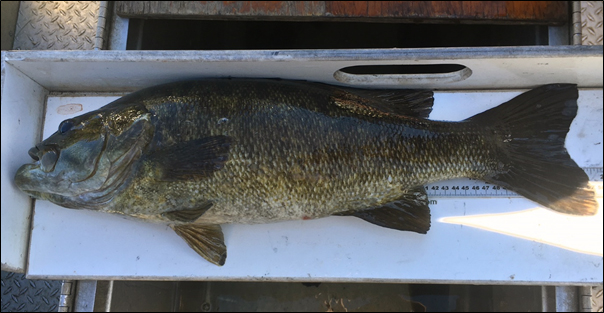
Image 1. 22.5 inch smallmouth bass collected in 2019 fall electrofishing survey
from Shepherdstown section of the upper Potomac River.
October 25, 2019
To supplement 2019 natural recruitment in sections of the upper Potomac River, Freshwater Fisheries was able to purchase 2,000 juvenile smallmouth bass produced by an out-of-state commercial hatchery. These young smallmouth bass measured between 4-5 inches in length had been tested and passed all required fish health screenings. Staff were able to transport the fish back to Maryland and stock them at points along the river from Brunswick upstream to Dam 4. These sections of the river have experienced low smallmouth bass recruitment due to high spring flows for the past several years. The goal of this supplemental stocking is to improve the overall smallmouth bass population as these fish grow to adult size over the next 2-3 years. Efforts will continue in 2020 to produce juvenile smallmouth bass from state hatcheries.
After 6 weeks in the prepared ponds at Manning Fish Hatchery, staff saw very limited spawning activity from the adult smallmouth bass. Fish were seen grouped together in the water but not near any of the prepared spawning beds or boxes on the pond bottom. Last week hatchery staff seined the pond to check for smallmouth bass fingerlings. None were collected in the nets. Unfortunately, even with the appropriate water temperature and substrate, spawning did not occur. As a result we will not have any smallmouth bass fingerlings to stock into the upper Potomac River this year. We knew this was one of the possible outcomes with this project. Ponds conditions were good, but for whatever reason the adult smallmouth bass did not cooperate.